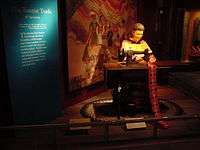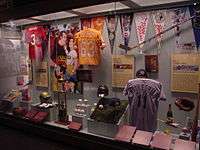Tampa Bay History Center
 | |
| Established | 2009 |
|---|---|
| Location | Tampa, Florida, United States |
| Coordinates | 27°56′34″N 82°27′01″W / 27.942702°N 82.45041°W |
| Website |
www |
Tampa Bay History Center is a history museum in Tampa, Florida. Exhibits include coverage of the Tampa Bay area's first native inhabitants, Spanish conquistadors, and historical figures who shaped the area's history, as well as a reproduction of a 1920s cigar store. The museum is on the waterfront at 801 Old Water Street in Tampa’s Channelside District. It opened on January 17, 2009.
The History Center building is60,000 square feet (5,600 m2) with 25,000 square feet (2,300 m2) of exhibit space.[1][2][3]

The Tampa Bay History Center includes three floors of permanent and temporary exhibition space covering 12,000 years of Florida history, with a special focus on Tampa Bay and the Gulf Coast. The History Center has a museum store, classrooms, the Witt Research Center (a branch of the Tampa-Hillsborough County Public Library System), a map gallery, an event hall and the Columbia Cafe (a branch of Ybor City's Columbia Restaurant).
The History Center is one of the largest on the west coast of Florida and includes hands-on, kid-friendly activities, as well as cutting edge interactive exhibits and theaters.
The Tampa Bay History Center is open daily from 10:00 a.m. until 5:00 p.m. Regular admission is $12.95 for adults, $10.95 for students, seniors and children between the ages of 13 and 17, and $7.00 for children ages four to twelve.
Tampa Bay History Center timeline
Hillsborough County was 14 times its present size when it was established by the Florida Territorial Legislature in 1834. Its boundaries included all or part of 24 present-day counties, stretching from Ocala to Lake Okeechobee and St. Petersburg to Orlando.[4]
In the early 1880s, Tampa residents expressed concern that there was no organized effort to preserve and display local artifacts. In the January 19, 1882, issue of The Sunland Tribune, County Judge J. G. Knapp wrote, "... no time should be lost in snatching the historical artifacts from the waste and death of oblivion. Who shall do it?"
Fast forward 100 years:
- 1986: The Hillsborough County Commission assembles a taskforce to explore the feasibility of creating a regional history museum.
- 1989: The History Museum of Tampa-Hillsborough County, Inc., a 501(c) 3 not-for-profit, is established by a group of private citizens led by Tampa businessman J. Thomas Touchton.
Mr. Touchton serves as Chairman of the Board of Trustees until 2000.
- 1993: A small museum space opens in the Shoppes of Harbour Island, showcasing objects from the museum’s collection and from other local and statewide institutions.
- 1993: The History Museum of Tampa-Hillsborough County, Inc. officially changes its name to the Tampa Bay History Center (TBHC).
- 1995: The Hillsborough County Commission charges TBHC with the care, in perpetuity, of the County collection.
- 1996: TBHC moves to the Tampa Convention Center Annex on Franklin Street, serving the community with permanent and traveling exhibitions, public programs, tours, outreach, research assistance, and publications.
- 1998: The Hillsborough County Commission commits $17 million in Community Investment Tax funds toward the planning and construction of a new museum building for TBHC.
- 2000: Attorney George B. Howell III succeeds J. Thomas Touchton as Chairman of TBHC's Board of Trustees and continues the commitment of the board, staff, members, and volunteers to acquire a permanent home for the museum.
- 2004: Tampa and Hillsborough County leaders sign an agreement to build the new History Center in Cotanchobee-Fort Brooke Park on a 2.4-acre tract secured by the City of Tampa through a grant from the Florida Communities Trust.
- February 2006: To complete the process of building the new museum, The Campaign to Create the Tampa Bay History Center Experience is authorized by the Board of Trustees.
- September 2006: The Capital Campaign is launched, requiring the History Center to raise $28 million in private funds, $17 million more than its initial pledge of $11 million to the Hillsborough County Commission. Mr. Touchton chairs the campaign.
- October 2007: Construction begins on the museum's new 60,000-square-foot (5,600 m2) home — Hillsborough County's first publicly owned LEED Certified "Green Building".
- October 2007: Because of the success of the campaign and the need for an additional $4.5 million
to build out the new museum, the Board of Trustees agrees to increase the private campaign goal from $28 million to $32 million.
- March 2008: TBHC closes its museum space on Franklin Street to begin staging for the move into the new building.
- June 2008: Local dignitaries, guests, board members, and staff gather with more than 200 construction workers to celebrate the last milestone of construction — the topping-out of the Tampa Bay History Center.
- June 2008: The History Center receives word that it has been awarded a $1-million challenge grant from the prestigious Kresge Foundation to help build the museum and its exhibits. To receive the $1-million grant, the History Center must complete its fundraising campaign by April 1, 2009.
- January 2009: The History Center celebrates the grand opening of its new facility.
- March 2009: The History Center successfully meets the Kresge Challenge, raising $32 million in private contributions five days ahead of schedule.
- October 2009: The History Center Building, which owned by Hillsborough County, is renamed the J. Thomas Touchton Tampa Bay History Center Building.
Exhibits
The museum's exhibition galleries explore 500 years of recorded history and 12,000 years of human habitation in the Tampa Bay region.
FIRST FLOOR

Icons of Tampa Bay The museum’s main entrance, the glass-enclosed Lykes Atrium, showcases 14 colorful icons representing historic characters, events, and symbols unique to the Tampa Bay region. Icons include: 1902 Oldsmobile; tug boat; Gasparilla ship; Tampa streetcar; B-26 bomber; Florida cowhunter; Babe Ruth; Tampa cigar label; longshoreman; strawberry plane citrus label; steam engine; Tampa Bay marquee; flamenco dancer; and tarpon angler.
Winds of Change Theater Beginning with Pánfilo de Narváez’s landing near Tampa Bay in 1528, Winds of Change profiles some of the first European explorers who came to Florida. Shot on location in Florida, the film features historical characters portrayed by local re-enactors.

Florida's First People The Tocobaga and Calusa tribes resided in Central and South Florida beginning over 12,000 years ago. The Florida’s First People exhibit features original and replica artifacts from pre-European contact ranging from the Paleoindian Period (12,000 B.C.-6,000 B.C.) through the Mississippian Period (1,000 A.D.-1,600 A.D.). Tools, weapons, and pottery are displayed, along with original artwork by St. Augustine artist Theodore Morris.
European Exploration Story Using an oversized map of the Atlantic Ocean, the European Exploration exhibit details the arrival of Spanish and French explorers who landed in Florida at the beginning the 16th Century. Artifacts are related to Spanish exploration, including period clothing, weapons, and tools.



Seminole and Miccosukee Story The Charles L. Knight Gallery features a collection of Seminole and Miccosukee artifacts, including clothing, patchwork, jewelry, baskets, tools, and weapons. Visitors can enjoy a multisensory theater experience, Coacoochee’s Story, and view a replica chickee—a structure made of palmetto thatch over a cypress log frame.

Cigar City This exhibit tells the story of Tampa’s cigar industry and immigrant communities in Ybor City, West Tampa, and Palmetto Beach. Visitors can walk through a 1920s-era cigar store and cigar factory; explore topics such as immigration, politics, and culture; and view cigar manufacturing and label printing artifacts, original furniture, and a model of a West Tampa cigar factory.
SECOND FLOOR
Your Tampa Bay This interactive map of the Tampa Bay region enables visitors to take a virtual tour of significant landmarks. Visitors can view photographs and detailed information about each point of interest.
Cowmen & Crackers This exhibit puts viewers in the middle of an actual cattle drive on the Lightsey Ranch in Kissimmee. Artifacts include branding irons, whips, saddles, and other ranching-related equipment. Kids can pretend to brand a cow and ride a horse.
A Place of Our Own Our area’s natural resources support industries in phosphate mining, fishing, and agriculture. The Land & Sea area features a grove stand filled with “Floridiana,” a restored 1908 Reo automobile, and a “design your own crate label” interactive station.
Port City The story of Tampa’s industrial ports begins with an introductory film inside an actual shipping container-turned-theater. Kids can also play with a hands-on “Tiny Tampa” port interactive.

Year Round Play This gallery highlights Tampa’s year-round recreational and social activities. The Gasparilla and Strawberry festivals are highlighted, as are Tampa’s professional sports franchises.
Witness to Change This gallery looks at significant events that were catalysts for change in the Tampa Bay region, focusing on three areas: civil rights, urban development, and the natural environment.
War Stories Focusing on wars that have touched our state and region since the 1830s, visitors can learn about war artifacts using an interactive timeline, and view a model of Fort Brooke.
A Land Remembered Inspired by Patrick Smith’s novel by the same name, this exhibition includes a replica pioneer cabin and original artifacts. Kids can try on pioneer clothes and play games in a hands-on Discovery Center.
Tampa Bay Timeline A series of large panels with compelling photographs, renderings and artifacts, this timeline tracks 500 years of history in Tampa Bay beginning with European contact in 1528.
J. Thomas and Lavinia W. Touchton Collection of Florida Cartography Contains nearly 3,000 maps and charts of Florida spanning 500 years.
THIRD FLOOR
Temporary Exhibitions Gallery The 2,500-square-foot (230 m2) temporary gallery houses a rotating schedule of traveling exhibitions from other institutions, as well as temporary installations developed by TBHC staff.
References
- ↑ "Tampa Bay History Center opens as jewel of city". The Tampa Tribune. January 18, 2009. Retrieved 31 January 2010.
- ↑ Hooper, Ernest (February 10, 2009). "Dreamer's work for Tampa Bay History Center will endure for generations". St. Petersburg Times. Retrieved 31 January 2010.
- ↑ "Tampa Bay History Center lands $1 million". Tampa Bay Business Journal. August 25, 2008. Retrieved 31 January 2010.
- ↑ Atlas of Historical County Boundaries, Long, John H.